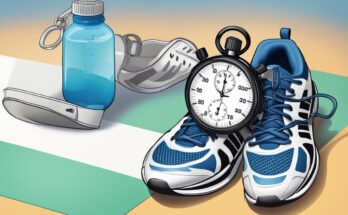First of all, you can become a runner. Run easy and take small steps. Millions of people enjoy running because it is good for the body and mind and requires very little equipment. The food you eat is like gasoline.
Unless you need t
What You Need to Know Before Running: Tips for Beginner Runners
Running is a great way to stay in shape, but it’s important to know what you’re doing before you hit the pavement. Whether you’re a seasoned runner or just starting out, there are some key things to keep in mind to ensure you stay safe and get the most out of your workout.
First and foremost, it’s important to invest in a good pair of running shoes. Running can be tough on your feet, and a proper pair of shoes can help prevent injuries and make your run more comfortable. Look for shoes with good arch support and cushioning, and make sure they fit properly.
Another important factor to consider is your form. Running with proper form can help prevent injuries and improve your overall performance. Focus on keeping your shoulders relaxed, your arms at a 90-degree angle, and your feet landing under your body rather than in front of it. It’s also important to avoid over-striding, which can put extra stress on your joints.
Benefits of Running
Running is a popular form of exercise that provides numerous benefits to both physical and mental health. Here are some of the benefits of running:
- Improved cardiovascular health: Running is an excellent way to strengthen your heart and lungs. It can help lower blood pressure, reduce the risk of heart disease, and improve overall cardiovascular health.
- Weight loss: Running is an effective way to burn calories and lose weight. It can help you maintain a healthy body weight and reduce the risk of obesity-related health problems.
- Stronger bones and muscles: Running can help improve bone density and strengthen muscles, which can reduce the risk of osteoporosis and other bone-related health problems.
- Stress relief: Running can help reduce stress and anxiety levels. It can also improve mood and mental health by releasing endorphins, which are natural mood-boosters.
- Improved sleep: Running can help improve sleep quality and reduce the risk of sleep-related health problems.
- Increased energy: Running can help increase energy levels and improve overall physical performance.
Overall, running is a great way to improve your physical and mental health. It is a simple, low-cost, and effective form of exercise that can be done almost anywhere. However, it is important to start slowly and gradually increase your running distance and intensity to avoid injury.
Potential Risks of Running
Running is a great way to stay in shape and improve your overall health. However, like any physical activity, running also comes with potential risks that you should be aware of before starting a running routine.
Injury
One of the most common risks associated with running is injury. Running puts a lot of stress on your joints, muscles, and bones, which can lead to strains, sprains, and other injuries. To reduce your risk of injury, it’s important to start slowly and gradually increase your mileage over time. You should also wear proper running shoes that provide adequate support and cushioning.
Dehydration
Running can also lead to dehydration, especially if you’re running in hot weather. To prevent dehydration, make sure to drink plenty of water before, during, and after your run. You should also avoid running during the hottest part of the day and wear lightweight, breathable clothing to help regulate your body temperature.
Overtraining
Another potential risk of running is overtraining. Running too much or too often can lead to burnout, fatigue, and a higher risk of injury. It’s important to give your body time to rest and recover between runs, and to listen to your body’s signals if you start to feel overly tired or fatigued.
Conclusion
While running can be a great way to improve your health and fitness, it’s important to be aware of the potential risks involved. By taking the necessary precautions and listening to your body, you can help reduce your risk of injury, dehydration, and overtraining, and enjoy all the benefits that running has to offer.
Pre-Run Checklist
Before you hit the pavement, it’s important to make sure you’re prepared for your run. Here’s a pre-run checklist to help you get started:
- Check the weather: Make sure you dress appropriately for the weather conditions. If it’s cold outside, wear layers to stay warm, and if it’s hot, wear breathable clothing to stay cool.
- Hydrate: Drink plenty of water before your run to stay hydrated. It’s also a good idea to bring water with you on your run, especially if you’re running for an extended period of time.
- Warm up: Take a few minutes to warm up before you start running. This can include stretching, light jogging, or other low-intensity exercises to get your blood flowing and your muscles ready for activity.
- Check your gear: Make sure your shoes are in good condition and fit properly. If you’re using any other equipment, such as a fitness tracker or heart rate monitor, make sure they’re charged and ready to go.
- Plan your route: Know where you’re going before you start running. This can help you stay on track and avoid getting lost. It’s also a good idea to let someone know where you’re going and when you plan to be back.
By following this pre-run checklist, you can help ensure a safe and enjoyable running experience. Remember to listen to your body and take breaks as needed, and always consult with a healthcare professional before starting any new exercise routine.
Proper Running Form
Proper running form is essential to help prevent injuries and maximize performance. Here are some tips to help you maintain good form:
- Keep your head up and look forward, not down at your feet. This will help you maintain good posture and prevent neck strain.
- Relax your shoulders and keep them down, away from your ears. Tension in your shoulders can lead to neck and upper back pain.
- Engage your core muscles by pulling your belly button towards your spine. This will help you maintain stability and prevent lower back pain.
- Keep your arms at a 90-degree angle and swing them back and forth, not across your body. This will help you maintain momentum and prevent unnecessary twisting.
- Land on the middle of your foot, not your heel or toes. This will help you absorb shock and prevent injuries.
- Keep your stride short and quick, not long and slow. This will help you maintain good form and prevent overstriding.
Remember to start slow and gradually increase your speed and distance. Listen to your body and rest when needed. With proper form and training, you can enjoy the many benefits of running while minimizing the risk of injury.
Essential Gear for Running
Running is a great way to stay fit and healthy, but it’s important to have the right gear to make the most of your workout. Here are some essential items you should consider before hitting the pavement:
- Running shoes: A good pair of running shoes is essential to prevent injury and provide support. Look for shoes that fit well and provide cushioning and stability.
- Moisture-wicking clothing: Running can be a sweaty activity, so it’s important to wear clothing that will keep you dry and comfortable. Look for fabrics that wick away moisture and allow for breathability.
- Headphones: Music can be a great motivator during a run. Invest in a good pair of headphones that will stay in place and provide good sound quality.
- Water bottle: Staying hydrated is important during a run, especially in hot weather. Bring a water bottle with you to ensure you can quench your thirst when needed.
These are just a few essential items to consider before hitting the pavement. As you become more experienced, you may want to invest in additional gear such as a GPS watch, compression socks, or a foam roller. Remember, the most important thing is to stay safe and comfortable during your run.
Common Running Injuries and How to Prevent Them
Running is a great way to stay healthy and fit, but it can also lead to injuries if you’re not careful. Here are some of the most common running injuries and how you can prevent them:
Runner’s Knee
Runner’s knee is a common injury that affects the knee joint. It’s caused by repetitive stress on the knee, which can lead to pain and inflammation. To prevent runner’s knee, make sure to wear proper shoes that provide good support for your feet. It’s also important to stretch before and after your runs, and to gradually increase your mileage over time.
Plantar Fasciitis
Plantar fasciitis is a painful condition that affects the bottom of the foot. It’s caused by inflammation of the plantar fascia, which is a band of tissue that runs from the heel to the toes. To prevent plantar fasciitis, make sure to wear shoes that fit well and provide good arch support. It’s also important to stretch your feet and calves before and after your runs, and to avoid running on hard surfaces.
Shin Splints
Shin splints are a common injury that affects the lower leg. They’re caused by inflammation of the muscles, tendons, and bone tissue in the shin. To prevent shin splints, make sure to wear shoes that provide good shock absorption and support. It’s also important to stretch your calves and shins before and after your runs, and to gradually increase your mileage over time.
IT Band Syndrome
IT band syndrome is a painful condition that affects the outside of the knee. It’s caused by inflammation of the iliotibial band, which is a thick band of tissue that runs from the hip to the knee. To prevent IT band syndrome, make sure to wear shoes that provide good support for your feet. It’s also important to stretch your hips and IT band before and after your runs, and to avoid running on uneven surfaces.
Achilles Tendinitis
Achilles tendinitis is a painful condition that affects the back of the heel. It’s caused by inflammation of the Achilles tendon, which is a band of tissue that connects the calf muscles to the heel bone. To prevent Achilles tendinitis, make sure to wear shoes that provide good support for your feet. It’s also important to stretch your calves before and after your runs, and to avoid running uphill or on hard surfaces.
By taking these steps to prevent common running injuries, you can enjoy the many benefits of running while minimizing your risk of injury.
Nutrition for Runners
Running is a great way to stay fit, but it’s important to fuel your body with the right nutrients to optimize your performance and recovery. Here are some key nutrition tips for runners:
- Carbohydrates: Carbs are the primary fuel source for endurance exercise, so it’s important to consume enough of them. Aim for complex carbs like whole grains, fruits, and vegetables, which provide sustained energy without spiking blood sugar levels.
- Protein: Protein is essential for muscle repair and recovery. Aim for lean sources like chicken, fish, eggs, and legumes.
- Fats: Healthy fats like avocado, nuts, and olive oil are important for overall health and can provide sustained energy for longer runs.
In addition to macronutrients, it’s important to stay hydrated before, during, and after runs. Aim for at least 8-10 glasses of water per day, and consider sports drinks or electrolyte supplements for longer runs in hot weather.
Timing is also important when it comes to nutrition for runners. Aim to eat a balanced meal 2-3 hours before a run to allow for proper digestion, and consume a small snack like a banana or energy bar 30 minutes before a run for an extra boost of energy.
Finally, listen to your body and adjust your nutrition plan accordingly. Every runner is different, so it’s important to experiment and find what works best for you.
Training Programs for Beginners
When starting to run, it is important to ease into it gradually to avoid injury and burnout. Here are some training programs for beginners:
1. Couch to 5K
The Couch to 5K program is a popular training program for beginners that gradually builds up endurance over a period of 9 weeks. It involves a combination of running and walking, with each week increasing the amount of running time and decreasing the walking time. By the end of the program, participants should be able to run a 5K without stopping.
2. Jeff Galloway Method
The Jeff Galloway Method involves a run-walk-run approach where beginners alternate between running and walking for set intervals. The intervals can be customized based on the individual’s fitness level and goals. This method is designed to reduce the risk of injury and fatigue, while still building endurance.
3. Hal Higdon Novice Plan
The Hal Higdon Novice Plan is a 12-week training program that gradually builds up endurance and distance. It involves running 3-4 times per week, with longer runs on the weekends. This program is designed for those who have little to no running experience, and focuses on building a strong foundation for future training.
Remember, it is important to listen to your body and not push yourself too hard. Rest days are just as important as training days, and incorporating strength training and stretching can also help prevent injury and improve overall fitness.
Conclusion
Running is a great way to stay fit and healthy, but it’s important to approach it with caution and knowledge. Before you start running, make sure you have the right gear, including supportive shoes and comfortable clothing. Start slowly and gradually increase your distance and speed to avoid injury.
It’s also important to pay attention to your body and listen to any warning signs of injury or exhaustion. Staying hydrated and fueling your body with nutritious foods can help you perform your best and avoid injury.
Finally, don’t forget the mental aspect of running. Set achievable goals and track your progress to stay motivated. Remember that running should be enjoyable, and don’t be too hard on yourself if you have an off day.
o rest because of injury or illness, avoid long periods of time without running to develop and maintain muscular and cardiovascular strength and endurance. Before lacing up your shoes, check out these 8 tips for beginners from running expert Sascha Wingenfeld https://www.runtastic.com/blog/en/8-extremely-useful-running-tips-for-beginners/ , Start with short intervals of running. Before lacing up your running shoes, check out these 8 extremely useful tips for beginners from running expert Sascha Wingenfeld, Start with short running intervals. Whole foods (fruits, vegetables, lean proteins and whole grains) are the best type of fuel.




